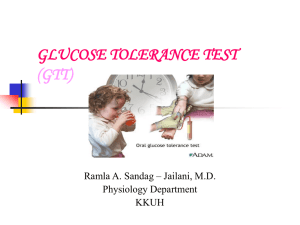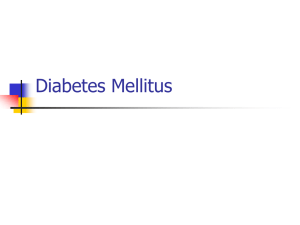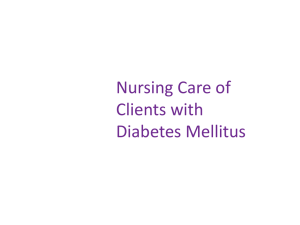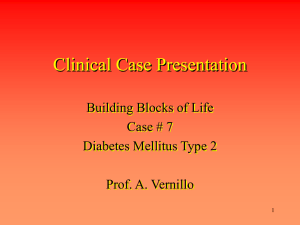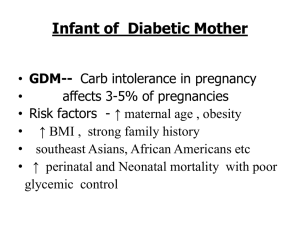COMMONLY PERFORMED LABORATORY TESTS/PROCEDURES
advertisement
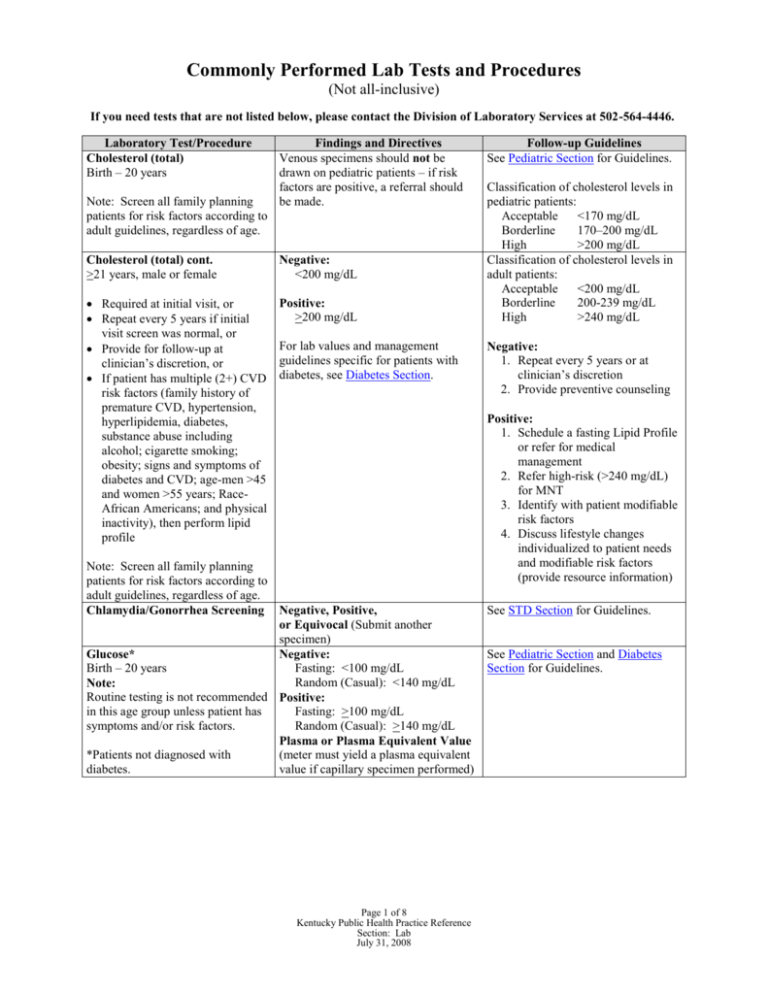
Commonly Performed Lab Tests and Procedures (Not all-inclusive) If you need tests that are not listed below, please contact the Division of Laboratory Services at 502-564-4446. Laboratory Test/Procedure Cholesterol (total) Birth – 20 years Note: Screen all family planning patients for risk factors according to adult guidelines, regardless of age. Findings and Directives Venous specimens should not be drawn on pediatric patients – if risk factors are positive, a referral should be made. Cholesterol (total) cont. >21 years, male or female Negative: <200 mg/dL Required at initial visit, or Repeat every 5 years if initial visit screen was normal, or Provide for follow-up at clinician’s discretion, or If patient has multiple (2+) CVD risk factors (family history of premature CVD, hypertension, hyperlipidemia, diabetes, substance abuse including alcohol; cigarette smoking; obesity; signs and symptoms of diabetes and CVD; age-men >45 and women >55 years; RaceAfrican Americans; and physical inactivity), then perform lipid profile Positive: >200 mg/dL For lab values and management guidelines specific for patients with diabetes, see Diabetes Section. Note: Screen all family planning patients for risk factors according to adult guidelines, regardless of age. Chlamydia/Gonorrhea Screening Negative, Positive, or Equivocal (Submit another specimen) Glucose* Negative: Birth – 20 years Fasting: <100 mg/dL Random (Casual): <140 mg/dL Note: Routine testing is not recommended Positive: in this age group unless patient has Fasting: >100 mg/dL symptoms and/or risk factors. Random (Casual): >140 mg/dL Plasma or Plasma Equivalent Value *Patients not diagnosed with (meter must yield a plasma equivalent diabetes. value if capillary specimen performed) Page 1 of 8 Kentucky Public Health Practice Reference Section: Lab July 31, 2008 Follow-up Guidelines See Pediatric Section for Guidelines. Classification of cholesterol levels in pediatric patients: Acceptable <170 mg/dL Borderline 170–200 mg/dL High >200 mg/dL Classification of cholesterol levels in adult patients: Acceptable <200 mg/dL Borderline 200-239 mg/dL High >240 mg/dL Negative: 1. Repeat every 5 years or at clinician’s discretion 2. Provide preventive counseling Positive: 1. Schedule a fasting Lipid Profile or refer for medical management 2. Refer high-risk (>240 mg/dL) for MNT 3. Identify with patient modifiable risk factors 4. Discuss lifestyle changes individualized to patient needs and modifiable risk factors (provide resource information) See STD Section for Guidelines. See Pediatric Section and Diabetes Section for Guidelines. Commonly Performed Lab Tests and Procedures continued (Not all-inclusive) Laboratory Test/Procedure Glucose Cont. Pregnant Female The Glucose Tolerance Test (GTT) should be performed in the morning after an overnight fast of between 8 to 14 hours and after at least 3 days of unrestricted diet (>150 g carbohydrates per day) and unlimited physical activity. The patient should remain seated and should not smoke throughout the test. Glucose Cont.* Postpartum Female Glucose Cont.* >21 years, male or non-pregnant female Notes: Test individuals with risk factors listed in the Diabetes Section. Screen all family planning patients for risk factors regardless of age. Previously identified impaired glucose metabolism or “prediabetes” (fasting plasma glucose of >100 but <126 mg/dL) OR previously identified impaired glucose tolerance (GTT 2 hr. plasma >140 but <200 mg/dL). Findings and Directives 50 gm Oral Glucose Load 1 hour after 50 gm load Plasma Glucose Negative: <140 mg/dL 100 gm Glucose Tolerance Test Diagnostic Criteria: Two or more of the venous plasma concentrations listed below must be met or exceeded for positive diagnosis. Fasting: 95 mg/dL 1 hour: 180 mg/dL 2 hour: 155 mg/dL 3 hour: 140 mg/dL Fasting glucose Negative: <100 mg/dL Positive: >100 mg/dL Plasma or Plasma Equivalent Value Negative: Fasting: <100 mg/dL Random (Casual): <140 mg/dL Positive: Fasting: >100 mg/dL Random (Casual): >140 mg/dL Note: Meter must yield a plasma equivalent value if capillary specimen performed Follow-up Guidelines See Gestational Diabetes Guidelines in the Prenatal Section. See Gestational Diabetes Guidelines in the Prenatal Section. Refer to Diabetes Section for guidelines. Negative: 1. Repeat periodic screening. 2. Provide counseling on nutrition, exercise, and risk factor reduction. Positive: 1. Refer all positive results to physician for follow-up. 2. Provide counseling on nutrition, exercise, risk factor reduction, food preparation and purchasing. 3. Refer for Medical Nutrition Therapy. *For patients not diagnosed with diabetes. Page 2 of 8 Kentucky Public Health Practice Reference Section: Lab July 31, 2008 Commonly Performed Lab Tests and Procedures continued (Not all-inclusive) Laboratory Test/Procedure Hemoglobin/Hematocrit Findings and Directives Age 6–12 months 1–<2 yrs. 2–< 5 yrs. 5–< 8 yrs. 8–<12 yrs. Male 12–<15 yrs. Female 12–<15 yrs. Male 15–<18 yrs. Female 15–<18 yrs. Male >18 yrs. Female >18 yrs. Pregnant Female: Trimester 1 Trimester 2 Trimester 3 Hepatitis B Hgb (gm/dL) <10.9 <10.9 <11.0 <11.4 <11.8 Hct (%) <32.8 <32.8 <32.9 <34.4 <35.3 <12.4 <37.2 <11.7 <35.6 <13.2 <39.6 <11.9 <35.8 <13.4 <39.8 <11.9 <35.6 <10.9 <10.4 <10.9 <32.9 <31.9 <32.9 Non-reactive (Negative) Repeatedly Reactive (Positive) Screen individuals with the following risk factors: 1. Prenatal patient for initial screen, obtain HBsAg. 2. Prenatal patient with known exposure to HBsAg positive partners, obtain HBsAg, AntiHBs and Anti-HBc 3. LHD Employee-Post-vaccine testing, obtain Anti-HBs at 1–2 mos. post-vaccine. 4. Employee Percutaneous or permucosal exposure: obtain baseline and 6 mos. (Anti-HBs) 5. Percutaneous or permucosal exposure, test source patient, obtain HBsAg. Follow-up Guidelines 1. Screen for WIC Services 2. For Hgb >9.0, Hct >27.0 but less than the recommended normals, repeat screen in 1–3 months. 3. Refer for medical evaluation when Hgb <9.0, Hct <27.0. 4. Refer to appropriate age section for follow-up. Household and sexual contacts who screen positive should be tested for Anti-HBc and AntiHBs. Refer to Reportable Disease Desk Reference. Infants born to HBsAg positive mothers should be tested 3–9 mos. after their third dose of hepatitis vaccine. (Obtain AntiHBs if testing post-immunization therapy.) Page 3 of 8 Kentucky Public Health Practice Reference Section: Lab July 31, 2008 Commonly Performed Lab Tests and Procedures continued (Not all-inclusive) Laboratory Test/Procedure HIV Testing & Counseling (Male and Female) Findings and Directives Non-reactive (Negative) Repeatedly Reactive (Positive) POSITIVE RESULTS ARE SIGNIFICANT. Follow-up Guidelines See HIV/STD Section for Guidance. Occupational – LHD Employee Percutaneous or permucosal exposure: recommended testing schedule is Baseline, 6 weeks, 3 months, 6 months, and 1 year. See Lead Section for guidance. Lead Screening (6 months to 6 years) Normal: Lead level of 0–9 µg/dL High Risk: Lead level of 10–14 µg/dL Lead Poisoning: Confirmed Lead Level of >15 µg/dL Lipid Profile, Fasting Note: Screen individuals for the following indications: Persons with total blood cholesterol of 200 mg/dL or greater Persons diagnosed with diabetes* Persons with multiple (2+) risk factors for CVD (family history of premature CVD, hypertension, hyperlipidemia, diabetes, substance abuse including alcohol; cigarette smoking; obesity; signs and symptoms of diabetes and CVD; age-men >45 and women >55 years; RaceAfrican Americans; and physical inactivity). Obtain at least every 5 years in adults age 21 and over Negative: Total cholesterol <200 mg/dL and HDL cholesterol >40 mg/dL and LDL <130 mg/dL and Triglycerides <150 mg/dL Negative: 1. Repeat screen in 5 years and at clinician’s discretion 2. Provide preventive counseling Positive: Total cholesterol >200 mg/dL or HDL <40 mg/dL or LDL >130 mg/dL or Triglycerides >150 mg/dL Positive: 1. Refer for Medical Evaluation 2. Refer high-risk (>240 mg/dL) for Medical Nutrition Therapy (MNT) at clinician’s discretion. For lab values that require MNT, see Nutrition Section 3. Identify with patient modifiable risk factors 4. Discuss lifestyle changes individualized to patient’s needs and modifiable risk factors 5. Document referral and return appointments 6. Repeat screen in 3 months and/or at clinician’s discretion *Note: Please refer to Diabetes Section for findings and follow-up guidelines. Page 4 of 8 Kentucky Public Health Practice Reference Section: Lab July 31, 2008 Commonly Performed Lab Tests and Procedures continued (Not all-inclusive) Laboratory Test/Procedure Metabolic (Newborn) Screening (Birth to 6 months of age) Findings and Directives Normal No further action necessary Positive Laboratory will make immediate referral to university specialist. NBS follow-up staff will notify PCP of referral and provide educational materials for PCP and parents. MS/MS tests by Category Amino Acid Disorders: Argininosuccinate Acidemia, Citrullinemia, Homocystinuria, Maple Syrup Urine Disease, Phenylketonuria, Tyrosinemia Fatty Acid Disorders: Carnitine uptake defect, Long-chain L-3hydroxyacyl-CoA dehydrogenase deficiency (LCAD), Medium-chain acyl-CoA dehydrogenase deficiency (MCAD), Short-chain acyl-CoA dehydrogenase deficiency (SCAD), Trifunctional protein deficiency, Very long-chain acyl-CoA dehydrogenase deficiency (VLCAD) Organic Acid Disorders: 3-methylcrotonyl CoA-Carboxylase Deficiency, Beta-ketothiolase, Glutaric acidemia type 1, Isovaleric acidemia, 3-hydroxy 3methylglutaric aciduria, Methylmalonic acidemia, methylmalonic acidemia mutase deficiency, Propionic Acidemia Follow-up Guidelines Unsatisfactory, and Normal but <24 Hours of Age are results that apply to all disorders in the Newborn Screening panel. Followup Guidelines will be the same for all disorders with these results. Unsatisfactory Rescreen Normal but <24 hours of age Rescreen when child is >24 hours of age (For MS/MS disorders only) Needs further testing Rescreen Abnormal Referral to Pediatric Metabolic Specialist will be made immediately For all disorders not performed by MS/MS (from Endocrine Disorders forward) Abnormal _____________________________ Rescreen _____________________________ Endocrine Disorders Congenital Adrenal Hyperplasia, Congenital Hypothyroidism Normal but transfused Recollect specimen 72 hours after last transfusion and send to KY State Lab Hemoglobinapathies Hemoglobin C disease, Sickle Cell Anemia, S-β thalassemia, Sickle Cell Trait (See Sickle Cell section of this document for detailed results) (See Sickle Cell section of this document for detailed results) Other Disorders Utilizing Red Blood Cell Analysis Biotinidase Deficiency Galactosemia Normal but transfused Abnormal result See Test Report ______________________________ Page 5 of 8 Kentucky Public Health Practice Reference Section: Lab July 31, 2008 Other Disorders Cystic Fibrosis Submit filter paper specimen to the Division of Laboratory Services, make sure filter paper is “in-date”, not expired. Allow specimen to dry for at least 3 hours before mailing and mail to Lab within 24 hours of obtaining (when possible). Ova and Parasites Note: Symptoms include: abdominal discomfort – cramps with diarrhea containing blood or mucus, chronic diarrhea. Transmitted fecal-oral route. Pinworm Prep Note: Symptoms include: abdominal discomfort, with pruritus ani, especially at night. Transmitted fecal-oral route. Pregnancy Test, urine Rubella Normal but transfused Any Abnormal Result See Test Report Presence (positive) or Recommend medical evaluation for acute or chronic condition. Absence (none found, negative) Presence (positive) or Recommend medical evaluation for acute or chronic condition. Absence (none found, negative) Negative or Positive IgG antibody evaluates immunity. Negative NOT Immune status Equivocal, Borderline or Uncertain Immune status Positive Immune See pregnancy test guidelines in Family Planning Section. Negative immune status: 1. Determine pregnancy status by history, date of LMP, and/or pregnancy test if necessary. 2. Offer one MMR vaccine to persons regardless of age who have never been immunized against MMR. 3. If patient is under age 21 and has never had MMR vaccine, can offer first and booster doses of MMR. 4. Counsel to avoid pregnancy for at least three months. Equivocal immune status: An equivocal value on two specimens 14 days apart may indicate a vaccine booster is needed. See management above (negative). Positive immune status: 1. Inform patient of evidence of protection against rubella 2. Inquire about history of vaccination against measles and mumps 3. Manage as above if no evidence of protection against measles and mumps Page 6 of 8 Kentucky Public Health Practice Reference Section: Lab July 31, 2008 Commonly Performed Lab Tests and Procedures continued (Not all-inclusive) Laboratory Test/Procedure Sickle Cell Submit filter paper specimen to Division of Laboratory Services, make sure filter paper is “in-date”, not expired. Allow specimen to dry for at least 3 hours before mailing and mail to Lab within 24 hours of obtaining (when possible). Findings and Directives Follow-up Guidelines For possible sickle cell patterns, see following table. Normal No further action necessary Normal but transfused Recollect specimen 90 days after last transfusion and send to KY State Lab Urinalysis Trait Disease Positive or Negative Refer to specific test Refer to specific test Recommend medical evaluation for acute or chronic conditions. VDRL Positive dipstick for Leukocytes, Nitrites, Glucose, Ketone bodies, Protein or Blood. Non-reactive Wet Mount Reactive: Confirmatory testing performed at the State Lab, including EIA, TPPA, FTA testing. See Specific Report. See STD Section for Guidance. Weakly reactive: Confirmatory testing performed at the State Lab, including EIA, TPPA, FTA testing. See Specific Report. Normal See STD Section for Guidance. Abnormal White Blood Cells Lactobacilli Clue Cells Trichomonas Yeast/budding yeast Refer to LHD Lab procedure manual and Family Planning Section of PHPR Page 7 of 8 Kentucky Public Health Practice Reference Section: Lab July 31, 2008 LABORATORY RESULTS FOR SICKLE CELL SCREENING Normal hemoglobin is identified as F=Fetal and A=Adult, abnormal hemoglobin is identified as Hemoglobin S, Hemoglobin C, or Variant. *Variant is defined as abnormal hemoglobin undifferentiated by the screen, not HB S or HB C. NOTE: Variant may be listed on report as V=Bart’s HB. Normal Trait (Carrier) Disease HB FA HB AA HB AF Normal Hemoglobin Pattern for a newborn, F predominant Normal Hemoglobin Pattern for an Adult Normal Hemoglobin, A predominant See Specific Test Report See Specific Test Report See Specific Test Report Shipping Laboratory Specimens to Division of Laboratory Services (DLS) Shipping containers and color-coded postage shipping labels are provided to the health department from DLS for the purpose of shipping specimens. - For definitions of the color-coded postage shipping labels and listing of possible shipping methods, see the Attachments Section of Volume I of the Administrative Reference. Packaging and Shipping of Infectious Substances Department of Transportation (DOT) (http://www.dot.gov/), Domestic Mail Manual (DMM) (http://pe.usps.gov/), and International Air Transport Association (IATA) guidelines must be followed in determining if a specimen for shipping is classified as infectious substance category A or biological substance category B. Employees responsible for infectious substance packaging and shipping (either category A or B) must be trained and certified by their employer within 90 days of employment. The training guidelines are found in the DOT regulations at the DOT website: http://www.dot.gov/. Training for packaging and shipping infectious substances must occur every 3 years if shipping solely by USPS. UN certified packages must be used and are defined in the DOT regulations and a 24–hour emergency number must be provided while the package is in transit if the specimen is sent Infectious substance category A. Page 8 of 8 Kentucky Public Health Practice Reference Section: Lab July 31, 2008

